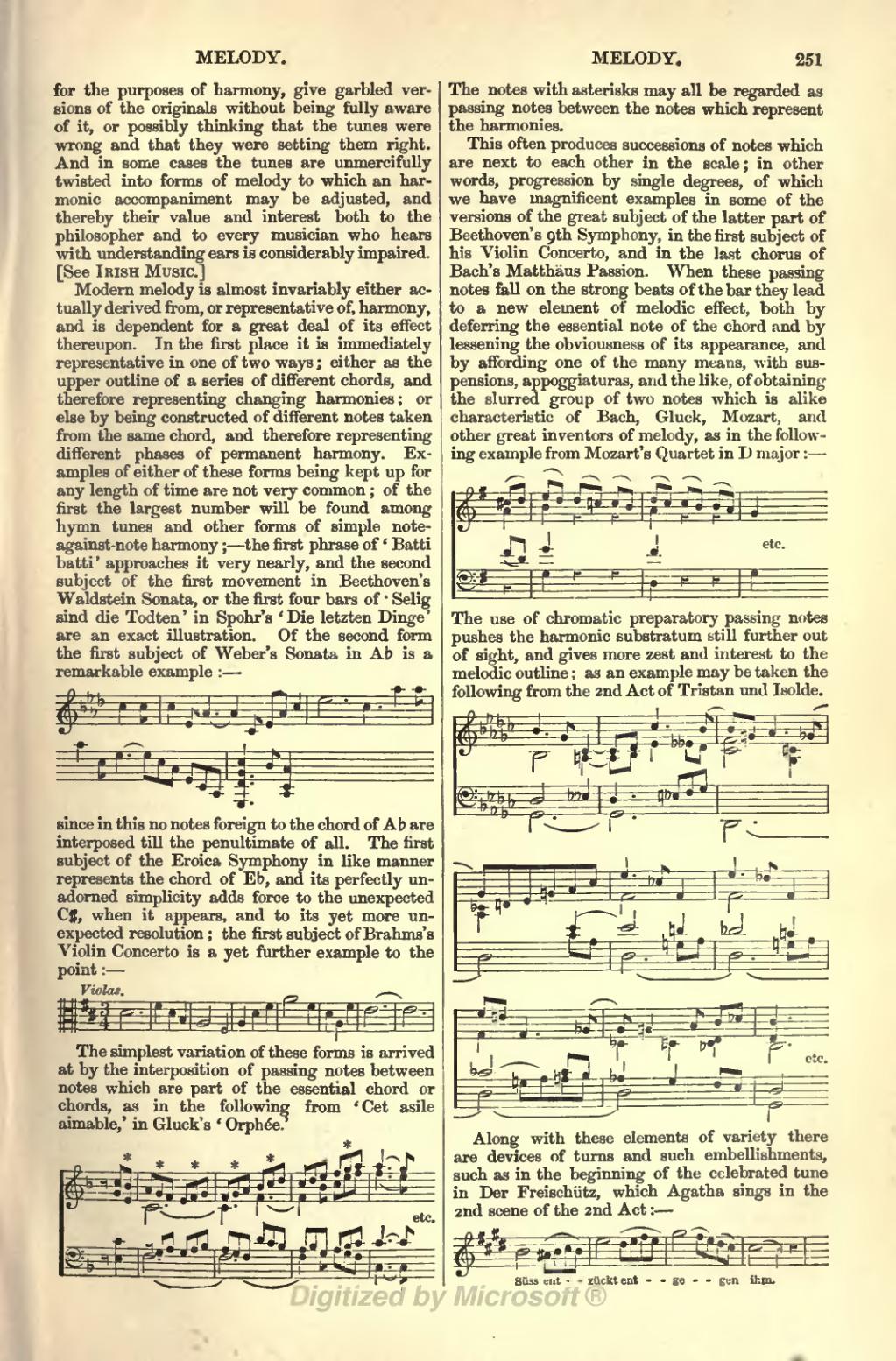for the purposes of harmony, give garbled versions of the originals without being fully aware of it, or possibly thinking that the tunes were wrong and that they were setting them right. And in some cases the tunes are unmercifully twisted into forms of melody to which an harmonic accompaniment may be adjusted, and thereby their value and interest both to the philosopher and to every musician who hears with understanding ears is considerably impaired. [See Irish Music.]
Modern melody is almost invariably either actually derived from, or representative of, harmony, and is dependent for a great deal of its effect thereupon. In the first place it is immediately representative in one of two ways; either as the upper outline of a series of different chords, and therefore representing changing harmonies; or else by being constructed of different notes taken from the same chord, and therefore representing different phases of permanent harmony. Examples of either of these forms being kept up for any length of time are not very common; of the first the largest number will be found among hymn tunes and other forms of simple note-against-note harmony;—the first phrase of 'Batti batti' approaches it very nearly, and the second subject of the first movement in Beethoven's Waldstein Sonata, or the first four bars of 'Selig sind die Todten' in Spohr's 'Die letzten Dinge' are an exact illustration. Of the second form the first subject of Weber's Sonata in A♭ is a remarkable example:—

since in this no notes foreign to the chord of A♭ are interposed till the penultimate of all. The first subject of the Eroica Symphony in like manner represents the chord of E♭, and its perfectly unadorned simplicity adds force to the unexpected C♯, when it appears, and to its yet more unexpected resolution; the first subject of Brahms's Violin Concerto is a yet further example to the point:—

The simplest variation of these forms is arrived at by the interposition of passing notes between notes which are part of the essential chord or chords, as in the following from 'Cet asile aimable,' in Gluck's 'Orphée.'

etc.
The notes with asterisks may all be regarded as passing notes between the notes which represent the harmonies.
This often produces successions of notes which are next to each other in the scale; in other words, progression by single degrees, of which we have magnificent examples in some of the versions of the great subject of the latter part of Beethoven's 9th Symphony, in the first subject [App. p.716 "second subject of the first movement"] of his Violin Concerto, and in the last chorus of Bach's Matthäus Passion. When these passing notes fall on the strong beats of the bar they lead to a new element of melodic effect, both by deferring the essential note of the chord and by lessening the obviousness of its appearance, and by affording one of the many means, with suspensions, appoggiaturas, and the like, of obtaining the slurred group of two notes which is alike characteristic of Bach, Gluck, Mozart, and other great inventors of melody, as in the following example from Mozart's Quartet in D major:—
![<< \new Staff { \override Score.Rest #'style = #'classical \override Score.TimeSignature #'stencil = ##f \time 3/4 \key g \major \partial 4 << \new Voice { \relative c'' { \stemUp \autoBeamOff \slurUp cis8[( d]) | e[( d]) d[( c!]) c[( b]) | d[( c]) c[( b]) b[( a]) | g4 } } \new Voice { \relative a' { \stemDown a4 | b r r | a r r | } } >> }
\new Staff { \clef bass \key g \major << \new Voice { \relative f' { \stemUp fis8( d) | g4 s s | fis } } \new Voice { r4 g r r d r r g } >> } >>](http://upload.wikimedia.org/score/3/o/3o0972u075l7mmnm6w5ewgo2u658prq/3o0972u0.png)
etc.
The use of chromatic preparatory passing notes pushes the harmonic substratum still further out of sight, and gives more zest and interest to the melodic outline; as an example may be taken the following from the 2nd Act of Tristan und Isolde.
![<< \new Staff { \override Score.TimeSignature #'stencil = ##f \time 3/4 \key ges \major << \new Voice { \relative b' { \stemUp bes4. ges8 ces,4 ~ | ces8 des ces'4. bes8 ~ | bes g aes4. ges8 ~ |
ges d ees g aes ces | ees4. ces!8 f,4 | ees'4. des!8 f,4 |
ees'8 d f,4. ges!8 ~ | ges g4 aes8 bes ces! | <bes d,>4. } }
\new Voice { \relative b { \stemDown bes2 a4 ~ | a8 bes ees4 eeses8 des | <ces f>2 <c g>4 | <ces aes>4 s2 | f2 s4 | f2 s4 | f4 s2 | ces4 c <ces des> | bes2 s8 } } >> }
\new Staff { \clef bass \key ges \major << \new Voice { \stemUp des2 eeses4 | des4. ees8 f ges | s2. | s2 ees'4 ^~ | ees'2 d'4 | des'2 c'4 | ces'2 ^~ ces'8 bes | aes!4 ges f8 ees | des2 s8^"etc." }
\new Voice { \stemDown s2. s s s | s2 g8 aes | s2 g8 aes | s4 g8[ aes a bes] }
\new Voice { \stemDown ges,2. _~ ges, | des,( des2) c'8 aes | des2. _~ des _~ des _~ des g,2 } >> } >>](http://upload.wikimedia.org/score/h/i/hix48fkns0txj6l27rssa3yi1621454/hix48fkn.png)
Along with these elements of variety there are devices of turns and such embellishments, such as in the beginning of the celebrated tune in Der Freischütz, which Agatha sings in the 2nd scene of the 2nd Act:—


